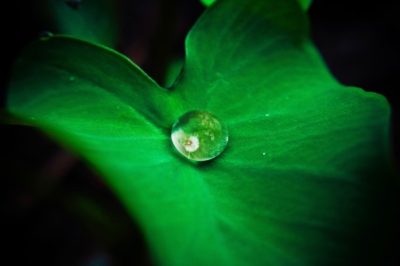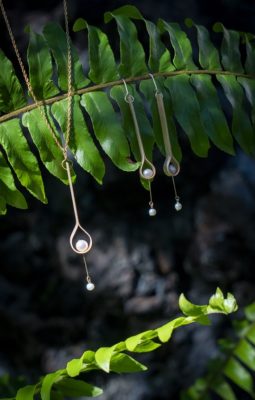 By Christine David
By Christine David
As a child, growing up in suburban Los Angeles, most of the dew-drops I noticed were on cold metal surfaces in my path; on the door handles as my brothers and I piled into the car in the early mornings when my mother would occasionally drive us to school, or on the rails lining the hallways there. At the time I considered dew a cold, wet inconvenience. Of course I didn’t know then that the cold metal had to be warmer at least than the surrounding air, or the dew wouldn’t be there at all to inconvenience me! Years passed, my perspectives have grown, and even though I learned long ago the physics behind dew’s collection, I have come to consider dew a gift; gently rinsing and cleansing all surfaces without prejudice, and what I feel now is wonderment.

When I first saw the the Shizuku-Dewdrop collection, I was struck by similar wonderment; such a gift… what is it doing here… how did it come to be? Having since studied some on the origins of Japanese aesthetics and the philosophies behind them, I begin to understand and my life is honestly the richer for it. The yūgen aesthetic of, “mysterious grace” is the one I am most aware of in Art De Tama’s first collection. In an innocuous dewdrop the artist, Tamao Nakayama, captures a moment so transient in its passing as to exemplify the impermanence of all things, and also, incredibly, suspends the moment indefinitely in time.
First, the stunning elegance of the lines of the pieces draw attention, then follows the realization that a maple tree, which lives 300 to 400 years, has been bent, somehow, into a delicate, nearly ethereal sculpture of a dew drop. Finally, fresh- water pearls, associated in eastern philosophies with wisdom and spiritual awareness, complete the path of the dew dropping.

The seemingly opposing perspectives of endurance and the fleeting have the effect of stunning the mind into a brief, timeless, effortless, and deeply calming silence; and in that moment out of time, perhaps revealing one of the most significant perspectives of the Zen Buddist philosophy from which the Japanese aesthetics are drawn. . . the realization that eternity is found not in unending time, but in the timeless perspective of the moment… what a gift.
For me, Tamao has accomplished the stated goal of the art she offers to share with us:
“My designs are intended to be wearable art that bring inner peace and calmness. Each piece is individually handcrafted with precision. I’m pleased to share my designs with you.”
Come Visit Art De Tama Fine Art!
Japanese artist in the United States. Tamao Nakayama was born and raised in Tokyo, Japan, and moved to the U.S. when she was 25 years old. She is still deeply influenced by the Japanese aesthetic, and the belief that ‘less is more’. She is a minimalist abstract artist. She paints and sculpts.
